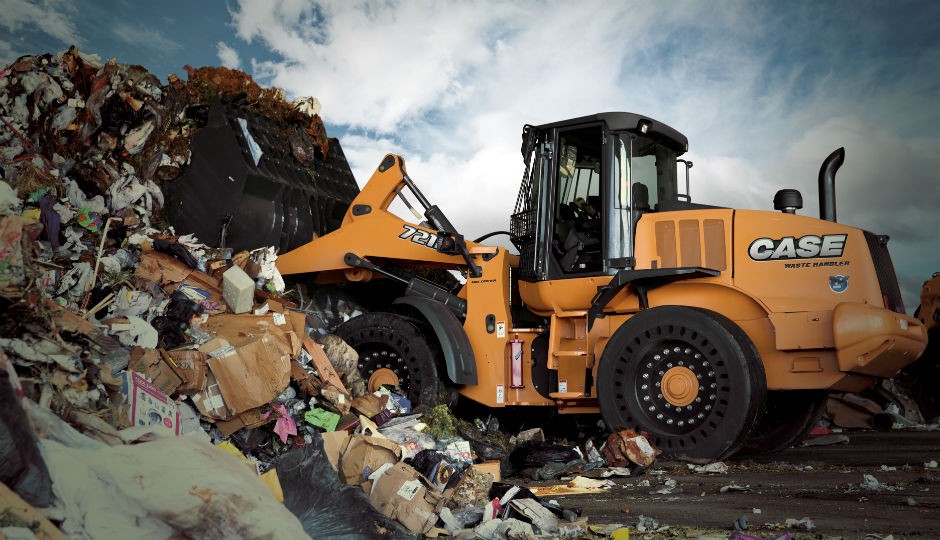Waste Handlers 101
From the latest Tier 4 engines to telematics and tires that won’t quit

For purpose-built wheel loaders, commonly referred to in waste and recycling as “waste handlers”, transfer stations and other materials processing facilities are among the most extreme environments that could possibly be encountered. Waste handlers can be outfitted with a number of features and performanceenhancers suited specifically for work in transfer station, landfill, composting and recycling applications, and are compatible with an extensive range of attachments from forks and grapples to buckets with rubber cutting edges. The right machine for each application will depend greatly on the available operating space, the type of material being handled and the operational demands put on the machine. Following are key factors to consider when evaluating waste handlers for waste/recycle applications.
Tier 4 engine options: SCR vs. CEGR
When it comes to Tier 4 engine options for waste handlers, there are two primary options available: Selective Catalytic Reduction (SCR) and Cooled Exhaust Gas Recirculation (CEGR). SCR is an after-treatment system that creates a chemical reaction by adding diesel exhaust fluid (DEF). This transforms NOx into nitrogen and water, which occur naturally in the atmosphere. CEGR operates differently: exhaust gases are cooled, blended with recirculated exhaust and returned to the cylinder, which lowers combustion temperatures and reduces NOx. Particulate matter (PM) levels are then reduced through the use of an after-treatment diesel particulate filter (DPF) system.
With the advent of Tier 4 engine technology, the biggest differentiators in recycling and waste applications come in terms of responsiveness and the heat produced by the engine – and in this application, SCR technology offers distinct advantages. SCR results in lower temperatures in the exhaust system while optimizing combustion with no downtime or extreme temperature spikes (compared to regeneration found on machines outfitted with CEGR technologies). An excellent side effect of this is lower fuel consumption by nearly 20 percent.
SCR is the practical choice for waste handlers because its tasks are variable, which creates inconsistent engine loads and power demands, as well as extended periods of idling. CEGR requires consistent engine speeds and temperatures to burn off the PM. If those temperatures are not met, the CEGR engine requires manual regeneration, which spikes engine exhaust temperatures and requires the machine to run for 10 to 20 minutes (without being operated) until the PM has been burned off. Manual regeneration with CEGR equates to downtime, while SCR lets the engine run at peak performance by using after-treatment, ensuring strong lift capacity and pushing power, as well as consistently fast cycle times and optimal uptime.
Keeping temperatures down in waste handling applications is critical in order to prevent thermal events from causing downtime. Waste handlers often work in tight quarters with excessive amounts of loose and potentially flammable material. While machines often come with cooling and fire suppression features, SCR engines inherently keep the average operating temperature lower than CEGR engines.
Machine size, cabs and specialized guarding
Size is important because many waste handlers are required to work in relatively tight/enclosed areas. Bigger is not always better – much of the waste material in transfer stations and recycling centres can be relatively light (when compared to other common wheel loader applications, such as aggregate mining). Machine size should be dependent on a careful study of the physical size of the facility and the expected volume of material to be handled. Lift capacity becomes more of a critical factor when dealing with heavier waste materials, such as scrap metals and glass, and high-density materials such as asphalt shingles.
Potential buyers should examine the total length and width of the waste handler, as well as test it to see how it operates with short, quick cycles in a tight envelope. Understanding its turning radius and the pocket it can operate in is important.
The key thing to look for in the cab is the visibility from the operator’s seat down to the bucket and to all sides of the machine, as greater visibility allows the operator to identify potential safety hazards.
Finally, due to the odd shapes and sizes of objects found in waste and recycling operations, and their uncanny ability to get stuck in critical operating areas, guarding packages are an important component to any waste handler, both for absorbing impact and ensuring equipment uptime. Most manufacturers provide customized guarding packages to meet the demands of each application.
A few of the most important guarding options to consider for applications in waste and recycling include: material ejectors metal-wrapped hoses; metal hose guards; windscreen guard; fire suppression systems; and reversible fans.
Solid tires and the advent of advanced telematics
Standard radial tires found on most wheel loaders are prone to puncture in waste applications. Solid tires – both the slick and treaded varieties – are excellent in waste applications to prevent puncture damage. It’s important that waste handlers with solid tires also feature a more robust axle design. CASE’s waste handler design includes a heavyduty axle design that is capable of withstanding 60 percent more load than standard models. One of the biggest advantages of a solid tire and the more robust axle system is the added weight on the back end of the machine. This added weight serves as ballast that significantly improves pushing operations, improves lift capacity and can allow for the use of larger buckets and other attachments.
Lastly, a telematics system that communicates critical machine data via GPS to a web-based software program, will simplify the storage, organization and reporting of critical machine information. Originally made popular in on-road trucks and commercial vehicles, telematics has found a niche in heavy equipment operation for its ability to modernize machine maintenance practices and improve overall fleet management. It is also a critical tool in monitoring Tier 4-related data (DEF fluid level, CEGR regeneration information) and will help fleet managers identify operator inefficiencies such as excessive idling.



